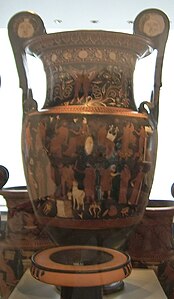
Black-figure pottery painting, also known as the black-figure style or black-figure ceramic, is one of the styles of painting on antique Greek vases. It was especially common between the 7th and 5th centuries BCE, although there are specimens dating as late as the 2nd century BCE. Stylistically it can be distinguished from the preceding orientalizing period and the subsequent red-figure pottery style.

Red-figure vase painting is one of the most important styles of figural Greek vase painting.

Euphronios was an ancient Greek vase painter and potter, active in Athens in the late 6th and early 5th centuries BC. As part of the so-called "Pioneer Group,", Euphronios was one of the most important artists of the red-figure technique. His works place him at the transition from Late Archaic to Early Classical art, and he is one of the first known artists in history to have signed his work.

Arthur Dale Trendall, was a New Zealand art historian and classical archaeologist whose work on identifying the work of individual artists on Greek ceramic vessels at Apulia and other sites earned him international prizes and a papal knighthood.

Asteas was one of the more active ancient Greek vase painters in Magna Graecia, practicing the red-figure style. He managed a large workshop, in which above all hydriai and kraters were painted. He painted mostly mythological and theatrical scenes. He is one of the few vase painters of the Greek colonies whose name comes down to us.

South Italian is a designation for ancient Greek pottery fabricated in Magna Graecia largely during the 4th century BC. The fact that Greek Southern Italy produced its own red-figure pottery as early as the end of the 5th century BC was first established by Adolf Furtwaengler in 1893. Prior to that this pottery had been first designated as "Etruscan" and then as "Attic." Archaeological proof that this pottery was actually being produced in South Italy first came in 1973 when a workshop and kilns with misfirings and broken wares was first excavated at Metaponto, proving that the Amykos Painter was located there rather than in Athens.

The Sisyphus Painter was an Apulian red-figure vase painter. His works are dated to the last two decades of the fifth century and the very early fourth century BC.

The Ilioupersis Painter was an Apulian vase painter. His works are dated to the second quarter of the 4th century BC.
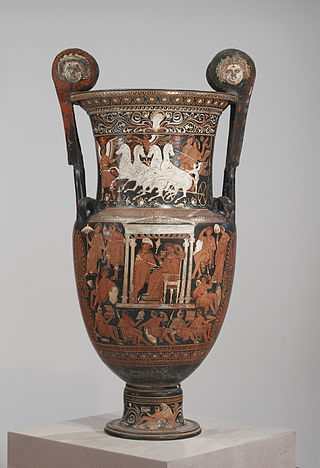
The Baltimore Painter was an Apulian vase painter whose works date to the final quarter of the 4th century BC. He is considered the most important Late Apulian vase painter, and the last Apulian painter of importance. His conventional name is derived from a vase kept at the Walters Art Museum in Baltimore.

The Tarporley Painter was a Greek Apulian red-figure vase painter. His works date to the first quarter of the 4th century BC. The Tarporley Painter is his period's most important representative of the so-called "Plain Style". He is considered to have been the pupil and successor of the Sisyphus Painter, as indicated by his elegant fine-limbed figures and the solemn facial expressions of his woman and cloaked youths. He painted garments in a less balanced style then the Sisyphus Painter. His heads are often oval and lean forwards. The spaces between his figures are often filled with flowers, branches or vines. Over time, his drawing style becomes more fluid, but also less precise. He painted especially on bell kraters, on which he often depicted dionysiac themes and theatrical scenes. His work includes the first known phlyax vase, showing the punishment of a thief, accompanied by a metric verse inscription. Mythological scenes by him are rare. There appears to be an especially close relationship between the work of the Tarporley Painter and that of the Dolon Painter, perhaps they cooperated directly for some time. His succession is represented by three separate schools, each clearly influenced by him. The most important painter of the first is the Schiller Painter, of the second the Hoppin Painter and of the third the Painter of Karlsruhe B9 and the Dijon Painter.

The Varrese Painter was an Apulian red-figure vase painter. His works are dated to the middle of the 4th century BC.
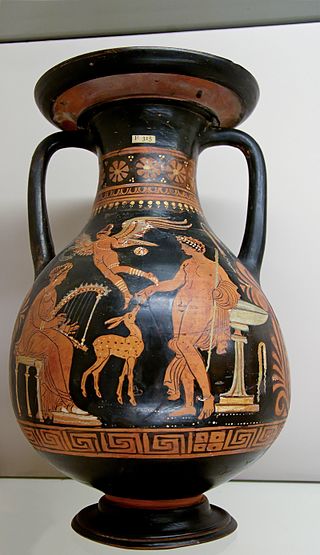
Apulian vase painting was a regional style of South Italian vase painting from ancient Apulia in Magna Graecia. It comprises geometric pottery and red-figure pottery.

Etruscan vase painting was produced from the 7th through the 4th centuries BC, and is a major element in Etruscan art. It was strongly influenced by Greek vase painting, and followed the main trends in style over the period. Besides being producers in their own right, the Etruscans were the main export market for Greek pottery outside Greece, and some Greek painters probably moved to Etruria, where richly decorated vases were a standard element of grave inventories.

Sicilian vase painting was a regional style of South Italian red-figure vase painting fabricated in Magna Graecia. It was one of five South Italian regional styles. The vase painting of Sicily was especially closely connected with the Lucanian and Paestan styles.

Campanian vase painting is one of the five regional styles of South Italian red-figure vase painting fabricated in Magna Graecia. It forms a close stylistic community with Apulian vase painting.
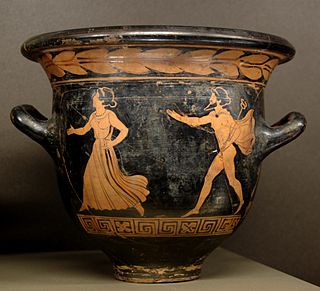
Lucanian vase painting was substyle of South Italian red-figure vase painting fabricated in Magna Graecia, produced in Lucania between 450 and 325 BC. It was the oldest South Italian regional style. Together with Sicilian and Paestan vase painting, it formed a close stylistic community.

Paestan vase painting was a style of vase painting associated with Paestum, a Campanian city in Italy founded by Greek colonists of Magna Graecia. Paestan vase painting is one of five regional styles of South Italian red-figure vase painting.

The Underworld Painter was an ancient Greek Apulian vase painter whose works date to the second half of the 4th century BC.

The Painter of the Berlin Dancing Girl was an Apulian red-figure vase painter, who was active between 430–410 BC. He was named after a calyx krater in the collection of the Antikensammlung Berlin, which depicts a girl dancing to the aulos played by a seated woman.
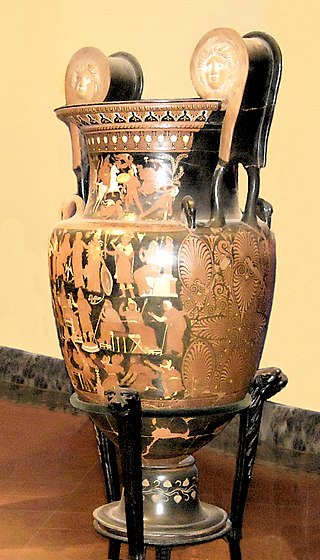
The Darius Vase is a famous vase painted by an anonymous Magna Graecia Apulian vase painter, commonly called the Darius Painter, the most eminent representative at the end of the "Ornate Style" in South Italian red-figure vase painting. The vase was produced between 340 and 320 BCE, probably in a large factory-like workshop in the Greek city of Taranto, Magna Graecia, well before the fall of Taranto to the Romans in 272 BCE. It is an important part of Apulian vase painting.




